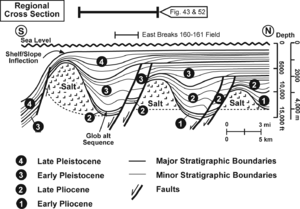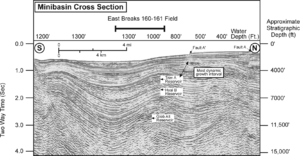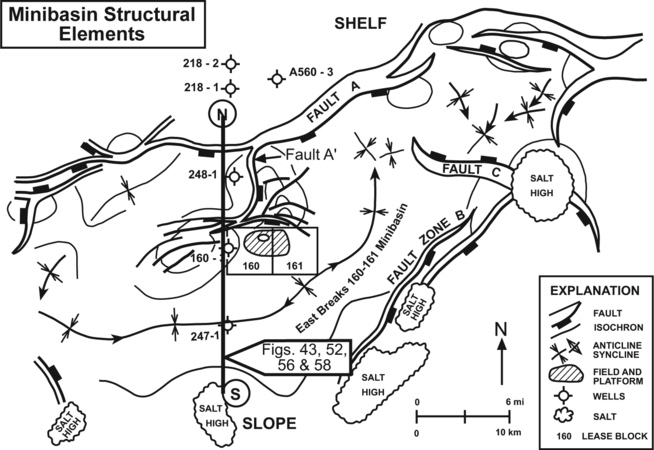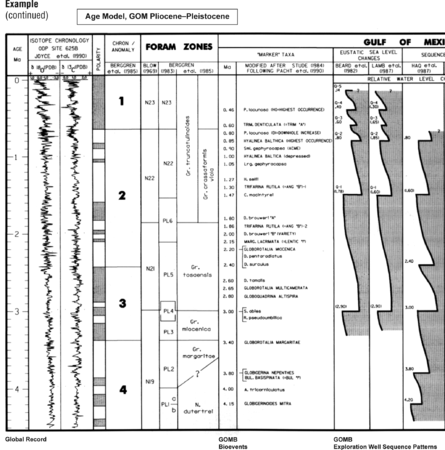Difference between revisions of "East Breaks trap formation"
FWhitehurst (talk | contribs) |
Cwhitehurst (talk | contribs) m (added Category:Treatise Handbook 3 using HotCat) |
||
| (25 intermediate revisions by 2 users not shown) | |||
| Line 6: | Line 6: | ||
| part = Critical elements of the petroleum system | | part = Critical elements of the petroleum system | ||
| chapter = Sedimentary basin analysis | | chapter = Sedimentary basin analysis | ||
| − | | frompg = 4- | + | | frompg = 4-96 |
| − | | topg = 4- | + | | topg = 4-96 |
| author = John M. Armentrout | | author = John M. Armentrout | ||
| link = http://archives.datapages.com/data/specpubs/beaumont/ch04/ch04.htm | | link = http://archives.datapages.com/data/specpubs/beaumont/ch04/ch04.htm | ||
| Line 16: | Line 16: | ||
==Minibasin structural-stratigraphic development== | ==Minibasin structural-stratigraphic development== | ||
| − | The structural/stratigraphic configuration of the East Breaks 160-161 minibasin formed well after ''Glob alt'' | + | [[File:Sedimentary-basin-analysis fig4-44.png|thumb|300px|{{Figure number|1}}Schematic diagram of the seismic reflection profile along the west side of the East Breaks 160-161 field. From Armentrout and Clement;<ref name=ch04r10 /> courtesy Gulf Coast SEPM.]] |
| + | |||
| + | The structural/stratigraphic configuration of the East Breaks 160-161 [[minibasin]] formed well after ''Glob alt'' deposition. As discussed earlier, the High Island–East Breaks basin was a late Pliocene - early Pleistocene slope basin through which [http://cdn.intechopen.com/pdfs-wm/25729.pdf gravity flow sands] flowed southward. [[Depocenter#Sediment_supply_rate_and_facies_patterns|Progradation]] overloaded the underlying [[Halite|salt]] and minibasins formed as a succession of southward-stepping growth-fault/[http://www.beg.utexas.edu/indassoc/agl/pubs/Withdrawal.pdf salt-withdrawal] sediment thicks ([[:File:Sedimentary-basin-analysis fig4-44.png|Figure 1]]). | ||
==Structural traps== | ==Structural traps== | ||
| − | Within these minibasins, structural traps of gravity-flow sandstones formed | + | Within these minibasins, structural traps of [http://cdn.intechopen.com/pdfs-wm/25729.pdf gravity-flow sandstones] formed |
| − | * as fault-dependent closure at growth | + | * as fault-dependent closure at [[growth fault]]s, |
| − | * as anticlinal closure formed by | + | * as [http://www.glossary.oilfield.slb.com/en/Terms/a/anticline.aspx anticlinal closure] formed by [http://structuralgeology.50webs.com/pagef21.htm roll over] into growth faults, or |
| − | * by postdepositional tilting of sandstones that shale | + | * by postdepositional tilting of sandstones that shale out [[Dip|upstructure]] due to syndepositional pinching-out against sea-floor valley margins.<ref name=ch04r22>Bouma, A. H., 1982, [http://archives.datapages.com/data/specpubs/history2/data/a110/a110/0001/0550/0567.htm Intraslope basins in northwest Gulf of Mexico: A key to ancient submarine canyons and fans: Environmental processes: Model investigations of margin environmental and tectonic processes], in J. S. Watkins and C. L. Drake, Studies in Continental Margin Geology: AAPG Memoir 34, p. 567–581.</ref><ref name=ch04r53>Kneller, B., 1995, Beyond the turbidite paradigm: physical models for deposition of turbidites and their implications for reservoir prediction, in A. J. Hartley, and D. J., Prosser, eds., Characterization of Deep Marine Clastic Systems: Geological Society, London, Special Publication 94, p. 31–49.</ref> |
==Stratigraphic traps== | ==Stratigraphic traps== | ||
| − | Pure [[stratigraphic trap]]s occur where basinal sandstones completely bypassed updip areas subsequently filled by mud, providing both top seal and | + | Pure [[stratigraphic trap]]s occur where basinal sandstones completely bypassed [[Dip|updip]] areas subsequently filled by mud, providing both top seal and up dip [[lateral]] seal.<ref name=ch04r22 /><ref name=ch04r36>Galloway, W. E., and T. A. McGilvery, 1995, Facies of a submarine canyon fill reservoir complex, lower Wilcox Group (Paleocene), central Texas coastal plain, in R. D. Winn, Jr., and J. M. Armentrout, eds., Turbidites and Associated Deep-Water Facies: WEPM Core Workshop 20, p. 1–23.</ref> |
==Timing of fault movement== | ==Timing of fault movement== | ||
| − | Fault movement timing is critical for trap formation timing. Growth-fault rollover | + | |
| + | [[File:Sedimentary-basin-analysis fig4-43.png|thumb|300px|{{figure number|2}}North–south seismic section through the East Breaks 160-161 intraslope minibasin, showing the location of the East Breaks 160-161 field.]] | ||
| + | |||
| + | Fault movement timing is critical for trap formation timing. [[Growth fault|Growth-fault]] [http://structuralgeology.50webs.com/pagef21.htm rollover anticlines] develop by [[Dp|updip]] expansion and sediment entrapment on the downthrown side of the fault and consequent [[Dip|downdip]] sediment starvation and continued subsidence within the intraslope basin (see [[:File:Sedimentary-basin-analysis fig4-43.png|Figure 2]] for geometries above the ''Trim A'' interval along fault A′). Thus, the updip trap for [[http://cdn.intechopen.com/pdfs-wm/25729.pdf gravity gravity-flow sandstone] is the rollover into the fault, formed during the dynamic phase of fault movement. | ||
==Fault A′== | ==Fault A′== | ||
| − | In the East Breaks 160-161 minibasin, the fault splay fault A′ forms the northern boundary to the field (Figures | + | <gallery mode=packed heights=300px widths=300px> |
| + | Sedimentary-basin-analysis fig4-42.png|{{figure number|3}}Structural elements that define the East Breaks 160-161 minibasin, which is bound on the north by fault A, on the east by faults B and C, and on the south by a salt- cored high. From Armentrout et al.;<ref>Armentrout, J. M., S. J. Malacek, P. Braithwaite, and C. R. Beeman, 1991, Seismic facies of slope basin turbidite reservoirs, East Breaks 160-161 field: Pliocene–Pleistocene, northwest- ern Gulf of Mexico, in P. Weimer and M. J. Link, eds., Seismic Facies and Sedimentary Processes of Submarine Fans and Turbidite Systems: New York, Springer-Verlag, | ||
| + | p. 223–239.</ref> courtesy Springer-Verlag. | ||
| + | Sedimentary-basin-analysis fig4-31.png|{{figure number|4}}Composite chronostratigraphic chart that serves as an age model for the GOM basin Pliocene and Pleistocene, summarizing nine studies published between 1982 and 1993. From Armentrout;<ref>Armentrout, J. M., 1996, High-resolution sequence biostratigraphy: examples from the Gulf of Mexico Plio–Pleistocene, in J. Howell and J. Aiken, eds., High Resolution Sequence Stratigraphy: Innovations and Applications: The Geological Society of London Special Publication 104, p. 65–86.</ref> courtesy The Geological Society, London. | ||
| + | </gallery> | ||
| + | |||
| + | In the East Breaks 160-161 minibasin, the [[Growth fault|fault]] splay fault A′ forms the northern boundary to the field ([[:file:Sedimentary-basin-analysis fig4-43.png|Figures 2]] and [[:file:Sedimentary-basin-analysis fig4-42.png|3]]). The dynamic phase of this fault is recorded by the wedge-shaped sediment thickening into the fault, deposited between pre-''Hyal B'' (ca. 1.00 Ma) time of deposition and late ''Trim A'' (ca. 0.56 Ma) time of deposition ([[:file:Sedimentary-basin-analysis fig4-31.png|Figure 4]]). Its growth phase began about 1.20 Ma.<ref name=ch04r10>Armentrout, J. M., and J. F. Clement, 1990, Biostratigraphic calibration of depositional cycles: a case study in High Island–Galveston–East Breaks areas, offshore Texas: Proceedings, Gulf Coast Section SEPM 11th Annual Research Conference, p. 21–51.</ref><ref name=ch04r7>Armentrout, J. M., 1991, Paleontological constraints on depositional [[modeling]]: examples of integration of biostratigraphy and seismic stratigraphy, Pliocene–Pleistocene, Gulf of Mexico, in P. Weimer, and M. H. Link, eds., Seismic Facies and Sedimentary Processes of Submarine Fans and Turbidite Systems: New York, Springer-Verlag, p. 137–170.</ref> Sea-floor expression of this fault clearly indicates [[offset]] of [[Holocene]] sediments, showing that the fault is currently active ([[:file:Sedimentary-basin-analysis fig4-43.png|Figure 2]]). | ||
==See also== | ==See also== | ||
| Line 53: | Line 64: | ||
[[Category:Sedimentary basin analysis]] | [[Category:Sedimentary basin analysis]] | ||
[[Category:East Breaks]] | [[Category:East Breaks]] | ||
| + | [[Category:Treatise Handbook 3]] | ||
Latest revision as of 21:54, 22 March 2022
| Exploring for Oil and Gas Traps | |

| |
| Series | Treatise in Petroleum Geology |
|---|---|
| Part | Critical elements of the petroleum system |
| Chapter | Sedimentary basin analysis |
| Author | John M. Armentrout |
| Link | Web page |
| Store | AAPG Store |
Minibasin structural-stratigraphic development

The structural/stratigraphic configuration of the East Breaks 160-161 minibasin formed well after Glob alt deposition. As discussed earlier, the High Island–East Breaks basin was a late Pliocene - early Pleistocene slope basin through which gravity flow sands flowed southward. Progradation overloaded the underlying salt and minibasins formed as a succession of southward-stepping growth-fault/salt-withdrawal sediment thicks (Figure 1).
Structural traps
Within these minibasins, structural traps of gravity-flow sandstones formed
- as fault-dependent closure at growth faults,
- as anticlinal closure formed by roll over into growth faults, or
- by postdepositional tilting of sandstones that shale out upstructure due to syndepositional pinching-out against sea-floor valley margins.[2][3]
Stratigraphic traps
Pure stratigraphic traps occur where basinal sandstones completely bypassed updip areas subsequently filled by mud, providing both top seal and up dip lateral seal.[2][4]
Timing of fault movement
Fault movement timing is critical for trap formation timing. Growth-fault rollover anticlines develop by updip expansion and sediment entrapment on the downthrown side of the fault and consequent downdip sediment starvation and continued subsidence within the intraslope basin (see Figure 2 for geometries above the Trim A interval along fault A′). Thus, the updip trap for [gravity gravity-flow sandstone is the rollover into the fault, formed during the dynamic phase of fault movement.
Fault A′
Figure 3 Structural elements that define the East Breaks 160-161 minibasin, which is bound on the north by fault A, on the east by faults B and C, and on the south by a salt- cored high. From Armentrout et al.;<ref>Armentrout, J. M., S. J. Malacek, P. Braithwaite, and C. R. Beeman, 1991, Seismic facies of slope basin turbidite reservoirs, East Breaks 160-161 field: Pliocene–Pleistocene, northwest- ern Gulf of Mexico, in P. Weimer and M. J. Link, eds., Seismic Facies and Sedimentary Processes of Submarine Fans and Turbidite Systems: New York, Springer-Verlag,
Figure 4 Composite chronostratigraphic chart that serves as an age model for the GOM basin Pliocene and Pleistocene, summarizing nine studies published between 1982 and 1993. From Armentrout;[5] courtesy The Geological Society, London.
In the East Breaks 160-161 minibasin, the fault splay fault A′ forms the northern boundary to the field (Figures 2 and 3). The dynamic phase of this fault is recorded by the wedge-shaped sediment thickening into the fault, deposited between pre-Hyal B (ca. 1.00 Ma) time of deposition and late Trim A (ca. 0.56 Ma) time of deposition (Figure 4). Its growth phase began about 1.20 Ma.[1][6] Sea-floor expression of this fault clearly indicates offset of Holocene sediments, showing that the fault is currently active (Figure 2).
See also
- East Breaks petroleum system
- East Breaks geochemistry
- East Breaks hydrocarbon generation model
- East Breaks hydrocarbon migration model
- East Breaks hydrocarbon accumulation model
- East Breaks critical moment
References
- ↑ 1.0 1.1 Armentrout, J. M., and J. F. Clement, 1990, Biostratigraphic calibration of depositional cycles: a case study in High Island–Galveston–East Breaks areas, offshore Texas: Proceedings, Gulf Coast Section SEPM 11th Annual Research Conference, p. 21–51.
- ↑ 2.0 2.1 Bouma, A. H., 1982, Intraslope basins in northwest Gulf of Mexico: A key to ancient submarine canyons and fans: Environmental processes: Model investigations of margin environmental and tectonic processes, in J. S. Watkins and C. L. Drake, Studies in Continental Margin Geology: AAPG Memoir 34, p. 567–581.
- ↑ Kneller, B., 1995, Beyond the turbidite paradigm: physical models for deposition of turbidites and their implications for reservoir prediction, in A. J. Hartley, and D. J., Prosser, eds., Characterization of Deep Marine Clastic Systems: Geological Society, London, Special Publication 94, p. 31–49.
- ↑ Galloway, W. E., and T. A. McGilvery, 1995, Facies of a submarine canyon fill reservoir complex, lower Wilcox Group (Paleocene), central Texas coastal plain, in R. D. Winn, Jr., and J. M. Armentrout, eds., Turbidites and Associated Deep-Water Facies: WEPM Core Workshop 20, p. 1–23.
- ↑ Armentrout, J. M., 1996, High-resolution sequence biostratigraphy: examples from the Gulf of Mexico Plio–Pleistocene, in J. Howell and J. Aiken, eds., High Resolution Sequence Stratigraphy: Innovations and Applications: The Geological Society of London Special Publication 104, p. 65–86.
- ↑ Armentrout, J. M., 1991, Paleontological constraints on depositional modeling: examples of integration of biostratigraphy and seismic stratigraphy, Pliocene–Pleistocene, Gulf of Mexico, in P. Weimer, and M. H. Link, eds., Seismic Facies and Sedimentary Processes of Submarine Fans and Turbidite Systems: New York, Springer-Verlag, p. 137–170.


